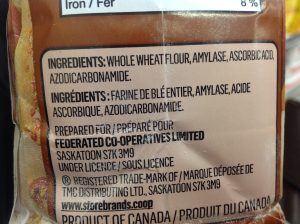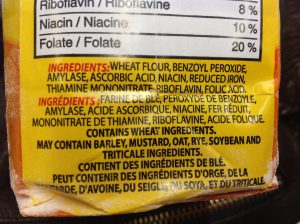What’s in YOUR flour?
Gone are the days that flour was simply ground wheat. The industry has changed drastically since our grandparents days of baking. Flour in the stores are anything but fresh, and certainly not WHOLE. Even whole wheat flours are now nothing more than white flour, with some bran added back. Commercialization has stripped the wheat of its nutrients in order for manufactures to store flour for years before being placed on the store shelf.
Have you ever taken the time to look at your ingredient list on your bag of flour? If not – take a look below.

Commercial Whole Wheat Flour

Commercial White Flour
Some of you may be surprised to see such a long list of ingredients. After all, isn’t wheat flour, just wheat? I’ve included a breakdown to explain each of these ingredients.
Amylase – is an enzyme that catalyses the hydrolysis (break down) of starch into sugars. It’s added to flours to better process the yeast used in baking to help the rise of your bread.
Ascorbic Acid – is vitamin C, but used as a preservative to give the flour a longer shelf life.
Azodicarbonamide – A flour bleaching and improving agent. You might have heard of this chemical compound from Subway’s announcement of discontinuing use of this in their breads. As you can see, it wasn’t just Subway that uses this chemical, it’s sadly very common in industrial flour. It’s added to make a stronger dough because it causes the bonding of the proteins in the flour and speeds the fermentation process. Scientists in the U.K. believe that azodicarbonamide is a possible cause of asthma and have banned its use. It’s also banned in the European Union and Australia, and Singapore has penalties of 15 years in prison and a $450,000 fine for using it.
Benzoyl Peroxide – used as a bleaching agent to give you a whiter flour. It can cause stomach upset in people who have digestive issues. When the stomach is more base than acidic, absorption of benzoyl peroxide decreases the natural breakdown and fermentation of glucose (the sugars that our bodies need to function properly) by 95%!!! Researchers have also speculated that benzoyl peroxide may interfere with how the body converts Omega-6 and Omega-3 acids.
Niacin, Reduced Iron, Thiamine Mononitrate, Riboflavin, Folic Acid – nutritional supplements. In industrial milling the wheat is stripped of its natural nutrients. Even in whole wheat flours, the germ is removed (the most nutritious part) and only a portion of the bran gets added back resulting it vast nutrition loss. To make up for the large loss of nutrition, supplements are added.
NORTH COUNTRY GRAINS WHOLE GRAIN DIFFERENCE
Our ingredient list is short – organic whole wheat flour.

Organic Whole Grain Flour
Nothing is taken away or added. You’re getting the full nutritional benefits of the entire grain. The wheat kernel is made up of three parts:
Endosperm – this is the part used in white flour. It’s a source of complex carbs, B-complex vitamins, and proteins when unrefined. Almost all white flours are refined, making white flour nothing more than a filler in our diets.
Bran – contains fiber, B-complex vitamins, trace minerals, and phytonutrients. Our flour contains 100% of the fiber found in wheat. Commercial whole wheat contains much less.
Germ – the nutrient powerhouse of wheat! A concentrated source of several essential nutrients including Vitamin E, folate (folic acid), phosphorus, thiamin, zinc, and magnesium, as well as essential fatty acids and fatty alcohols. It’s also a good source of fiber. It is very rare to find flours with the germ still intact. It greatly reduces shelf life of flour, and can cause it to go rancid if proper care is not taken. The Germ is removed in industrial milling because of the care needed to ensure a long shelf life. We believe it doesn’t have to be that way. We mill FRESH for each order, ensuring you fresh flour packed with nutrition!
So please, do yourself a favour – Try REAL – FRESH FLOUR – your body will thank you!
